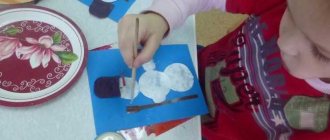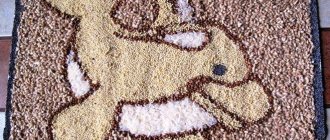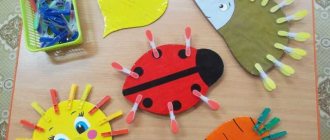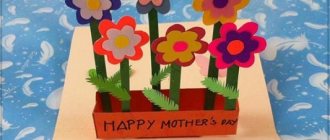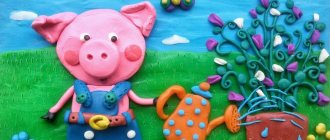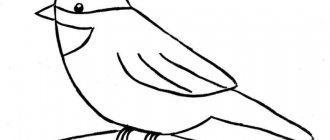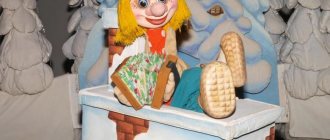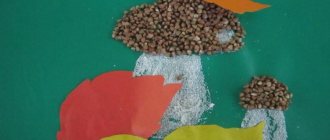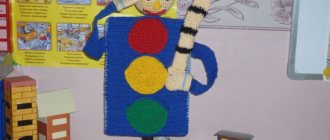Applique is one of the most interesting and fascinating types of creativity, because using figures cut out of any material, you can create any image with your own hands. All you need to create an applique is the right materials and creativity.
Application is a relatively inexpensive and at the same time useful form of creativity for children, since the necessary materials are not expensive, and the field for creative implementation and development of creativity is extremely wide!
The benefits of creating applications for schoolchildren
Starting from preschool, children are offered classes in this type of creativity. The application is of great interest to children and quickly captivates even the most restless children into the world of creativity and creativity!
What are the advantages of creating applications for schoolchildren?
- Development of hand motor skills
The process of creating an applique consists of a whole complex of different actions: cutting out various shapes with scissors, determining their location, attaching the shapes to paper with glue and finalizing the resulting applique using colored pencils, felt-tip pens or pens.
- Understanding the world around us
In addition to the fact that you can create any image you want, you can also use a whole range of materials: paper, scraps of fabric and natural ingredients.
The paper can be colored, corrugated or craft. When choosing fabric, the choice becomes even greater: cotton, wool, velor, felt, silk and so on.
Among the natural ingredients, sunflower seeds, pumpkin seeds, various cereals, pre-dried flowers, leaves and branches are most often used.
The use of all of the above materials broadens the child’s horizons. Children get acquainted with various types of materials of natural and non-natural origin and with all kinds of geometric shapes. With the help of them they embody their images in reality.
- Development of creative thinking and imagination
Creating applications is possible on any topic. Within a certain topic, be it fruits, vegetables, animals, landscapes or people, schoolchildren are given the opportunity to fully realize their vision of a particular topic on paper.
If a child has a talent for creating visual images, then appliqué is an excellent opportunity to reveal and increase their abilities.
Even if one of the children is not always able to create something interesting, the more the application is practiced, the faster the ability to create develops, and the imagination is enriched with new ideas and solutions.
The development of creative thinking is extremely important from an early age, since in adulthood it is much more effective to solve many issues using a creative approach.
- Aesthetic education
In the process of creating an image, you need to make a lot of effort: choose the shape of the material, choose colors that harmoniously combine with each other, and combine all the blanks into a complete work of art.
Each action in this creative process is aimed at developing aesthetic taste and the ability to correctly combine colors and shapes.
- Developing concentration and accuracy
Applique practice requires care. Working with scissors, glue and other materials, the child makes an effort to turn neat blanks into an equally neat image.
Extreme concentration on the creative process is also important. Only by completely immersing yourself in the process and concentrating all your attention on the moment “here and now” can you create something truly interesting and extraordinary.
At different stages of primary school education, applique classes always take place. But depending on the class, the process is somewhat modified, corresponding to the age and level of development of primary school students.
Summary of GCD in the middle group. Making a screen book “Kolobok”.
Galina Yuryevna Madrimova, teacher of the first qualification category, MADOU “Kindergarten No. 59”, Berezniki, Perm Territory
Making a screen book “Kolobok” for kids. Abstract of educational activities for the development of cooperation skills in children of the middle group.
Goal : To develop cooperation skills in children of middle preschool age when performing productive activities.
Pedagogical tasks : - Teach children to unite in pairs “out of sympathy”, to agree with each other on joint actions in creating their own page. — Strengthen the ability to hold scissors correctly, cut with them, and carefully paste parts of the image. — Strengthen the ability to cut corners of rectangles and squares. — Develop visual perception, the ability to navigate on a sheet of paper, tracing the function of the eyes. — Improve skills in sequential retelling of Russian folk tales
Practical task for children: Make your own page for the book “Kolobok”.
Materials: character pictures, ½ album sheet for gluing images, a set of colored squares and rectangles for cutting out, scissors, glue, napkin (for each pair of children), ready-made koloboks (4 pcs.), felt-tip pens for finishing the drawing.
Progress: 1. Involvement and motivation of children in activities. The teacher sits down at the children's table and pastes pictures (an old man and an old woman with a kolobok) onto the album sheet. He says to the children who came up: “I recently visited a group of kids, and they wanted to play the fairy tale “Kolobok,” but they couldn’t remember exactly who he met in the forest.” So I thought we could make some clue pictures for them. How do you think? (children agree). How can we do this? We need to think (children’s thoughts).
2. Pairing. The teacher invites the children to think about how we will work if there are 4 characters and 8 children. If the children do not guess, then the teacher himself suggests uniting in pairs. — Agree on who wants to take a picture with whom. Go up to your friend, look him in the eye and ask: Will you work with me? And to make it clear that you have found a mate, hold hands.
3. Distribution of activities. - To find out which fairy tale hero you will make a picture with, you need to draw out the character (character pictures lie upside down on the table) - Agree which of your pair will draw the picture. After this, the children decide in their pair who will do what. - Agree in your pair who will cut and who will paste. Then the teacher asks questions to each child in the pair: - What will you do? And you? Equipping a workplace for children: - Think about what you will need to design your page, take it and take it to your desk.
4. Carrying out activities by children. At this time, the teacher makes the first page of the screen book (a picture of a bun and the title of a fairy tale).
5. Evaluation of the result. Reflection. — Did you get a page? Why? - Thank your friend for your shared work. Say “thank you” to each other and hug. — What was difficult for you to do? What's easy? — Did you like working in pairs? Next time will you work together? - Now let's make our book - glue your leaves in order. Who did the bun meet first? Who has a bunny on their page? We will glue this piece of paper to my page (connects the sheets with tape). Who will meet the kolobok next? (So we discuss all the characters and put them together in a book). So we have a book, let’s go and give it to the kids.
Title: Summary of GCD in the middle group. Application. Making a screen book “Kolobok”.
Author: Madrimova Galina Yuryevna Position: teacher of the first qualification category Place of work: MADOU “Kindergarten No. 59” Location: Berezniki, Perm region
Also interesting material for the middle group: Abstract of educational activities in the educational field “Speech development” in the middle group
Date modified: July 25, 2015 Date published: July 25, 2015
Application for 1st grade
For children who have just come to school from kindergarten, it is necessary to organize exciting and interesting activities.
The main goal is to attract children to creativity as much as possible, to capture their attention and accustom them to active mental activity, initiative, flexibility and the desire for creative discoveries.
If children are interested in these activities at an early stage, then interest and involvement will grow in the future.
The most optimal method of conducting a lesson is a lesson in the form of a game with the addition of educational moments.
For example, when studying the topic “animals” or “plants” in the subject “Man and the World”, in a creative lesson you can be given the task of creating an image of an animal of your choice, while giving an additional task of memorizing some information on the topic.
Then it is worth organizing a presentation of the work, where each of the children will present the image they created with their own hands in public, accompanied by a short story.
Children 6-7 years old love fairy-tale and cartoon characters, because they actively watch cartoons, and their parents often tell them fairy tales. It is worth taking this feature into account and organizing classes on relevant topics.
Application for 2nd grade
Having become one year older, the children feel an even greater need to understand the world around them and creative self-realization. Applique lessons need to be made more challenging.
For example, by adding even more creative materials and increasing the choice of topics. After studying for a whole year at school, children begin to realize that with effort, it is possible to achieve something: both a good grade and praise from the teacher.
During this period, it is worth paying attention to technology and practical skills. Children should remember key points, if necessary, take notes on the course of actions and practice them.
Application for 3rd grade
As you grow older, your creativity grows. By the third grade, children had already mastered the skill of working with scissors, colored paper and glue. My horizons have expanded significantly and I have an idea of the world. At this point, it is necessary to give children freedom of expression and creative flight.
Lessons should be conducted using methods to develop imagination, and also introduce children to various techniques for cutting and folding materials. Some of the most interesting techniques are: cutting off shapes, accordion folding, cutting out complex shapes and decoupage.
How to make a bookmark for a book out of paper for children with a template
Let's start with a very simple bookmark made of colored paper, which is called a “tie”. It’s not at all difficult to make, so absolutely every child can cope with it. This is what the result will look like. Children in grades 1-4 especially like these crafts.
In total we will need four long strips of colored paper. It is important that they are the same width. The author of the master class uses white and orange colors. So, step one. Glue white and orange perpendicularly to a strip of white paper using double-sided tape.
Then glue another orange one on top of them, as shown in the photo.
Let's start weaving. Carefully fold the strips one after another.
We continue until we reach the end.
After that, trim off the excess. Use a hole punch to make a hole in the upper part of the bookmark and thread a thread into it. The “tie” for the book is ready!
You can make many different bookmarks from paper. For example, these are the Christmas trees (we’ll look at how they are created below).
This cute snake is also very easy to make.
Felt is also suitable as a material.
You might like paperclip bookmarks.
You can come up with more options than you think.
Applications for 4th grade
At the last stage of primary education, children finally develop the skills necessary for creativity. All that remains is to focus on further developing skills in working with materials and revealing the abilities of each student.
Classes must be conducted with the aim of maximizing creative potential, so that each student creates a completely unique and extraordinary work.
At this stage, applique classes should be partially transferred to home in the form of homework. Parents can help their child in the creative process by bringing in their ideas and showing other techniques for creating an image.
Plus, working on an applique together is a great way to spend time together!
Regular applique practice can significantly enrich your imagination and even develop accuracy. This is a rather painstaking process, and, moreover, when the work is finished, it is necessary to clean the workplace.
Creative development when practicing applique in childhood helps people of all kinds of professions in adulthood, for example, designers, architects, engineers and constructors, since this type of creativity develops creative thinking.
How to make a bookmark for books quickly and easily Unicorn
The next master class will also be devoted to origami techniques, and we will make a bookmark in the shape of a unicorn. What you need for a fantasy story or fairy tale.
Cut out a rectangle of approximately 5x15 cm from paper. Fold it in half along the long side.
And then in half again.
Open and bend the left and right edges towards the middle.
We turn the resulting workpiece over. We bend the left and right stripes approximately in half (towards the base of the triangle). Unfold, glue and fold again.
At the bottom of the workpiece, cut off all sharp corners.
Turn it over again and glue a strip under the base of the triangle.
Cut off the protruding part. Don't forget to cut the triangle.
Now let's make the mane. On a rectangle of white paper, we draw stripes one by one with multi-colored felt-tip pens.
Coat the edge of the leaf with glue.
Glue it to the workpiece and cut off all excess.
We make small cuts along the edge of the colored strip.
Cut out an ear from a piece of paper. Use a black felt-tip pen to complete the details.
Don't forget about the horn. We will cut it out of shiny gray paper and also glue it to the craft.
Ready!
